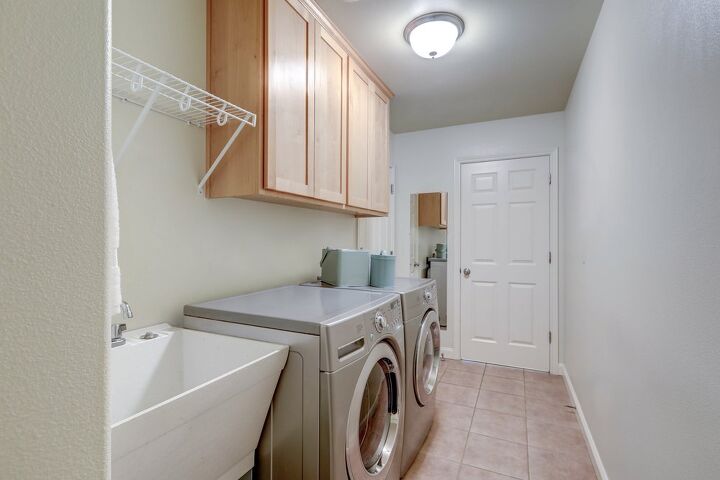2022 Cost to Relocate Washer & Dryer Hookups

Family needs have changed, and many older homes place the washer and dryer where they no longer fit our lifestyles. Many homes have washer and dryer connections in out-of-the-way locations like basements. Many homeowners wonder what it costs to relocate washer and dryer hookups to more convenient locations.
Moving washer and dryer hookups can range from $350 to more than $14,000. Moving to the other side of the wall can be as little as $350 for a plumber to turn the water and drain connections. Moving a basement laundry upstairs may run as much as $14,850 to run new water lines, drain lines, and install a vent pipe.
Plumbing and electrical work are the largest challenges to moving a washer and dryer. Each type of laundry room move has a set of challenges that can be expensive to solve. Understanding what expenses to expect with certain laundry room moves is critical to your budget and plans.
Do You Need to Hire a Plumber?
Get free, zero-commitment quotes from pro contractors near you.

Cost to Move a Washer and Dryer from the Basement Upstairs
A washer and dryer in a basement can mean multiple trips up and down several sets of stairs. How much more convenient is it to have the washer and dryer on the same floor where the laundry accumulates. On average, the cost of moving a washer and dryer upstairs is $14,850.
Adding new water lines, a new drain, a vent pipe, and new electrical circuits for your washer and dryer are expensive. Typically, this $14,850 does not include any structural work or remodeling to create a new laundry space.
Moving Washer and Dryer Hookups to the Other Side of the Wall
Your washer and dryer may need a simple relocation to the other side of the wall. In this case, the cost may only be approximately $350 for a plumber to turn the faucets and drain line and install a new laundry box on the new wall. AN electrician can move the existing electrical outlets to the same location.
Since you don’t need to install new plumbing or drains and very little construction work is involved, the price remains relatively low. Some homeowners may want to attempt this move themselves. Doing so can save much of the expense.
Cost to Move a Washer and Dryer to A Basement or Garage
Typically moving a washer and dryer downstairs to a basement or into a garage space is cheaper than moving upstairs. Moving into the basement usually puts you closer to water pipes and drainpipes that can be utilized or tapped. An outside vent is a need, and electrical connections installed
In most cases, you can expect the costs to run between 1,060 and $4,475 to make a move downstairs or into your garage. Costs can rise considerably if you need to make structural changes to accommodate the laundry space. You may find adding a fully-finished space for a laundry room to be as much as $15,000.
Moving Washer and Dryer Hookups in the Same Room
There are times when the washer and dryer hookups are not in a good place in a room. Moving washer and dryer hookups to a different location in the same room may be simple or involve considerable plumbing and electrical work.
Much like moving a washer and dryer upstairs or downstairs, moving across a room requires new water lines, drain lines and electrical service. The cost of moving the washer and dryer hookups in a room will be approximately the same as moving a washer and dryer upstairs. You may find the cost as little as $1,000 or reaching well above $7,000, depending on the project’s complexity.
Cost to Add a New Laundry Room
Often, there just isn’t a good place to relocate a washer and dryer from a basement or other inconvenient location. In these situations, considering the addition of a dedicated laundry area certainly is an option.
Adding a dedicated laundry space can add value to your home and preserves existing space for your family. In general, the size of the laundry space you add is a good indicator of the cost.
| Room Size | Square Feet | Average Price |
| 5’x5’ | 25 | $6,000 |
| 5’x7’ | 35 | $8,415 |
| 5’x9’ | 45 | $10,800 |
Cost of Moving the Washer and Dryer Hookup Yourself
Many homeowners have the skill and the tools to install a new washer and dryer hookups themselves. You can save money by doing much of the work yourself. However, you may still need to hire a plumber and electrician to make the final installation to meet local building codes and permit requirements.
In general, A do-it-yourselfer can expect to save about half the cost of having a plumber install a new washer and dryer hookup. Most of the cost is for the hookups and the electrical work. Typically, you can expect the materials to install a new washer and dryer hookup to be between $200 and $500, depending on how far your new location is to the nearest water supply line.
How Easy Is It to Move Washer and Dryer Hookups?
The answer to that question is, it depends. Several considerations factor into the ease of moving or adding a washer and dryer connection. Some of the questions to ask include:
- How far is it to the nearest hot and cold water lines? If the nearest water lines are across the house, it is much more expensive than hot and cold water lines in the floor or wall where you want to locate your new washer and dryer hookups. The same situation applies to electricity.
- You may have to remove flooring; wall finishes or ceilings to make the necessary connections for the new washer and dryer hookup. Crating openings for new water lines, and electrical connections can involve considerable skill in repairing or replacing these items.
- Many new plumbing installations are using PEX or poly pipe. Making these connections requires special tools and skills to ensure the system doesn’t leak. You may be able to rent the tools at your local home improvement center.
In the end, there is not just one set of skills needed to move a washer and dryer hookup. Some projects may require plumbing skills, carpentry skills, flooring skills, and electrical skills.
Do You Need a Permit to Move a Washer and Dryer Hookup?
Probably. Most building codes require a permit before you make any additions to the plumbing in your home. In addition, you will need an electrical work permit for new wiring for the washer and dryer hookups.
You should check with your local building inspection officials to find out more about permitting. Many jurisdictions give permits to homeowners to perform work on their property without being licensed. The permit will require an inspection, and the work you do must meet the building code. Most building inspectors will work with you to make sure you meet the requirements.
If I Build a New Laundry Room, How Big Should It Be?
The size and style of the washer and dryer dictate the minimum size of a laundry room. A typical washer and dryer need a space about five feet wide and four feet deep. If you install front-load type washers and dryers, you must allow space for the door swing and someone standing in front of the machine.
Most people also allow additional floor space for storage, such as cabinets and perhaps even a rinse sink. Cabinet top space is always a good addition, as is space to hang clothing as it comes out of the dryer.
Do You Need to Hire a Plumber?
Get free, zero-commitment quotes from pro contractors near you.

Making Laundry Day More Convenient
Adding, upgrading, or moving a washer and dryer hookup is a great way to make your home more livable. Good decisions about the placement of the laundry can add convenience and save steps. A new laundry center more conveniently located can change the character of a home. More convenience and fewer steps up and downstairs will certainly make someone in your house much happier.

Dennis is a retired firefighter with an extensive background in construction, home improvement, and remodeling. He worked in the trades part-time while serving as an active firefighter. On his retirement, he started a remodeling and home repair business, which he ran for several years.
More by Dennis Howard



























